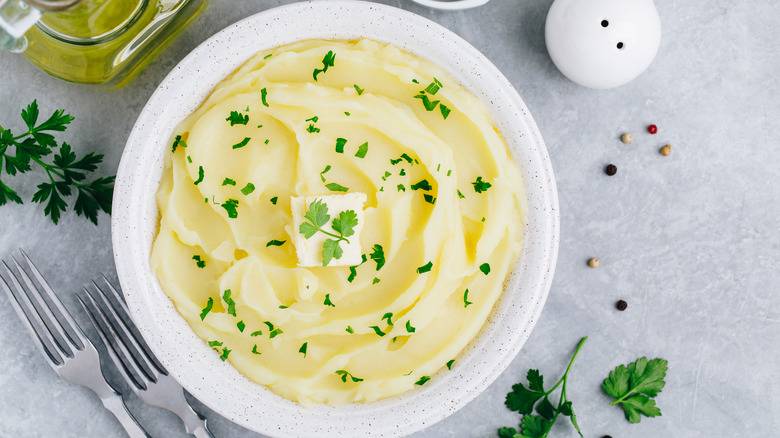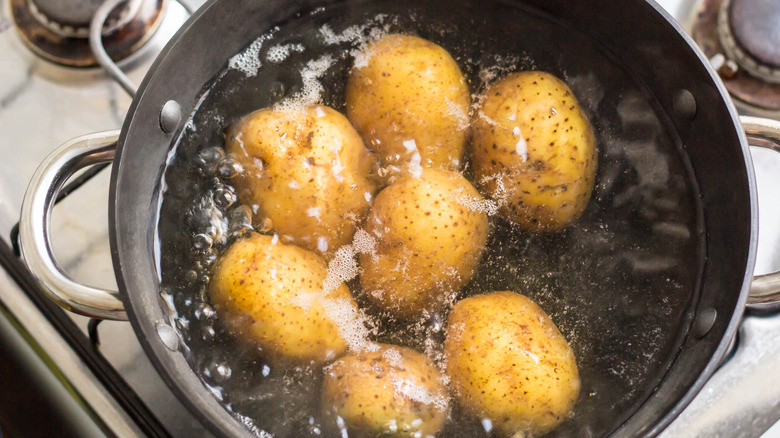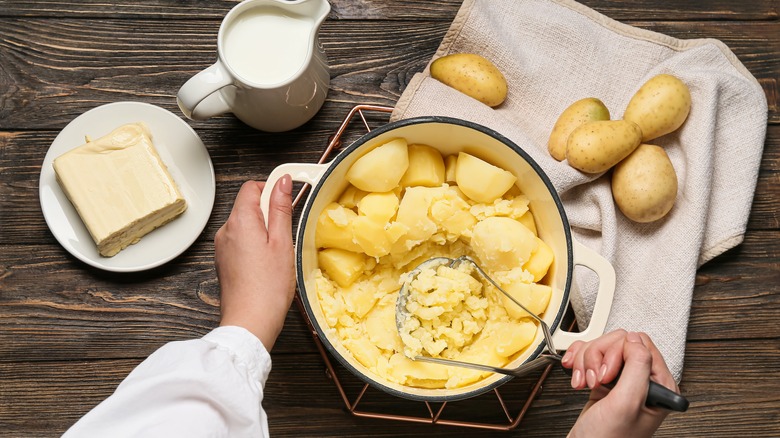The Absolute Best Type Of Potato For Mashed Potatoes
Everyone loves mashed potatoes, especially when served with turkey during family feasts throughout the year. They're the perfect side dish for almost any protein, and they're just plain delicious. Add some butter, garlic, cheese, and bacon, and you have one flavorful side dish. The question remains: What is the absolute best type of potato for mashed potatoes? We've done the research, and here's what we found:
Making mashed potatoes isn't a huge feat if you keep a few things in mind when cooking the classic comfort food fave, but which potatoes are best?
According to Martha Stewart, Yukon gold potatoes have yellow skin and create creamy mashed potatoes due to their medium-starch content. They also absorb less water, making them less likely to become gummy in texture. Yukon's rich, buttery flavor makes for creamy yet dense mashed potatoes that will please any crowd.
If pillowy-soft mashed potatoes are more your style, The Spruce Eats recommends that Russet potatoes should be your go-to. Russets are high in starch content and low in moisture, according to Idaho Potato, and they have the classic brown potato skins you're used to spotting in the grocery store. This type of potato makes light, soft mashed potatoes because they absorb more water than the Yukon.
Potato Cooking Tips
When you select your potato preference, there are a few tips you should keep in mind when prepping, cooking, and mashing your potatoes. Remove dirt, debris, and bacteria from the potatoes by washing the skins. The FDA recommends washing all produce first before preparing or eating it. You may choose to keep the skins on the potatoes or remove them for your mashed potatoes; it's solely up to personal preference. Cube the potatoes into one and a half to two-inch-wide cubes before adding them to the cool water.
Cooking potatoes causes a chemical reaction in the structure of the potato's starch grains. According to Idaho Potato, the starch is composed of pectin and starch molecules linked together to form the grain. As the potato cooks, the grains begin to swell and absorb the surrounding moisture in and around the potato. So, when boiling the cubed potatoes, Bon Appetit suggests using salted water to add flavor. The potatoes will absorb the salt during cooking, and it will cut down on salt addition later when the potatoes are ready to be served.
Boil, Drain, & Mash
Cover your potatoes with cold salted water and slowly bring them to a simmer, as Loaves and Dishes suggests. The gradual temperature increase will ensure that the potatoes cook evenly. When the water comes to a rolling boil, reduce the heat to a simmer. Fine Cooking's instructions recommend you check the potatoes for doneness by inserting a fork, skewer, or knife into the potato. The potatoes are fully cooked when the fork inserts without resistance.
When draining the potatoes, remove all of the water. Thoroughly draining reduces the chances of mushy mashed potatoes. As you add softened butter and seasonings, Lacademie says to re-add liquid in small amounts to moisten the potatoes. You can do this with milk, cream, chicken broth, or water.
Mashing the potatoes can be done with an old-fashioned potato masher or a fork. Keep in mind that, according to Serious Eats, the starch granules in the potatoes have softened and expanded, so over-mashing or using a food processor, for example, releases even more starch. Over-worked potatoes become sticky, thick, and glue-like, making for one unappetizing side dish. So, take it easy on the taters.
Whether your potatoes are light and fluffy or dense and creamy, they're sure to be a crowd-pleaser as a side dish for any occasion.


